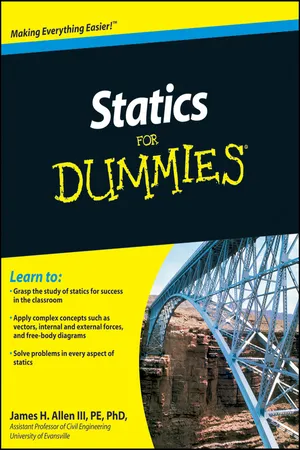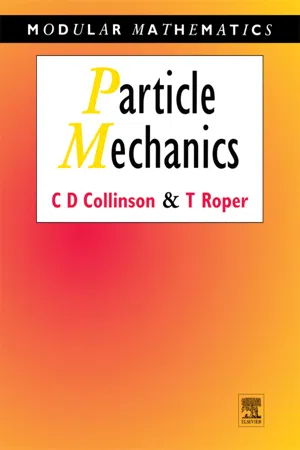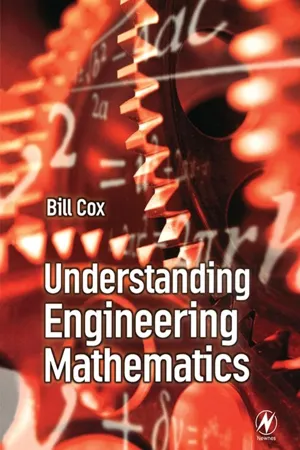Physics
Translation Vector
In physics, a translation vector represents the displacement of an object from one position to another in space. It is a mathematical quantity that describes the magnitude and direction of the movement. Translation vectors are used to analyze the motion of particles and objects, and they play a crucial role in understanding the dynamics of physical systems.
Written by Perlego with AI-assistance
Related key terms
8 Key excerpts on "Translation Vector"
- eBook - ePub
Doing Physics with Scientific Notebook
A Problem Solving Approach
- Joseph Gallant(Author)
- 2012(Publication Date)
- Wiley(Publisher)
Chapter 3Vectors
In the previous chapter, we described 1-dimensional motion. We specified an object’s position along one axis as either positive or negative. All information about the direction was carried by the sign.The universe is not 1-dimensional. There are more complicated motions that require more complicated descriptions. Fortunately, there are mathematical tools called vectors that will allow us to extend our study of motion to 2 and 3 dimensions. Vectors turn a difficult 2-d problem into two easy 1-d problems. That is a good trade.Many physical quantities can be described by a single number and a unit. Room temperature is approximately 21 °C and a typical class lasts about 3600 s. These numbers are called scalars. Temperature and time are examples of scalars. Scalars obey the usual rules of arithmetic. You can punch them into your calculator or use SNB. Scalars are old friends, the numbers you’ve been using for a long time. We just gave them a new name.Sometimes scalars are inadequate. Consider the following simple example. Suppose you walk 5 m, stop, then walk another 12 m. How far from your original location are you? It depends on the direction! Where you end up depends on both how far and in which direction you walk.If you only walk in one direction, you end up 5 m + 12 m = 17 m away from your initial position. If you walk 5 m to the left and then turn around and walk 12 m to the right, you end up 12 m - 5 m = 7 m to the right of your initial position. If you walk forward 5 m, turn right and walk another 12 m, you end up 13 m away from your initial position.Such quantities are called vectors. Vectors are mathematical quantities that have magnitude and direction. The vector’s magnitude tells us how much of the physical quantity we have. As Figure 3.1 - eBook - ePub
- Hiqmet Kamberaj(Author)
- 2021(Publication Date)
- De Gruyter(Publisher)
4 Two- and three-dimensional motionIn this chapter, we will discuss the kinematics of a particle moving in two and three dimensions. Utilizing two- and three-dimensional motion, we will be able to examine a variety of movements, starting with the motion of satellites in orbit to the flow of electrons in a uniform electric field. We will begin studying in more detail the vector nature of displacement, velocity, and acceleration. Similar to one-dimensional motion, we will also derive the kinematic equations for three-dimensional motion from these three quantities’ fundamental definitions. Then the projectile motion and uniform circular motion will be described in detail as particular cases of the movements in two dimensions.4.1 The displacement, velocity, and acceleration vectors
When we discussed the one-dimensional motion (see Chapter 3 ), we mentioned that the movement of an object along a straight line is thoroughly described in terms of its position as a function of time,x ( t ). For the two-dimensional motion, we will extend this idea to the movement in thex yplane.As a start, we describe a particle’s position by the position vector r pointing from the origin of some coordinate system to the particle located in thex yplane, as shown in Fig. 4.1 . At timet ithe particle is at point P, and at some later timet fit is at the position Q. The path from P to Q generally is not a straight line. As the particle moves from P to Q in the time intervalΔ t =, its position vector changes fromt f−t ir itor f.Definition 4.1 (Displacement vector).
The displacement is a vector, and the displacement of the particle is the difference between its final position and its initial position. We now formally define the displacement vector for the particle as the difference between its final position vector and its initial position vector:(4.1)Δ r =r f−r i.The direction ofΔ ris indicated in Fig. 4.1 from P to Q. Note that the magnitude ofΔ r - eBook - ePub
- James H. Allen(Author)
- 2010(Publication Date)
- For Dummies(Publisher)
Defining a VectorThis chapter focuses on exploring the behavior of vectors, seeing the commonalities in their construction, and understanding some of the subtle differences in their creation and application. In this chapter, I define the three major pieces of information you use to help a vector properly describe an action, I show you a few ways to draw a vector, and I break down the three primary types of vectors. This chapter won’t have you building a bridge immediately, but it does help you take your first step in getting a handle on the world around you in proper statics style.You quickly discover that the ability to create and define a proper vector is an invaluable set of skills. This ability lends itself fluidly to solving statics problems. However, before you can become truly proficient in statics, you first need to understand some basic terminology and the three pieces of information you need to properly define a vector.Simply put, a vectoris a quantity that helps describe the way that an action is applied to an object or group of objects. For example, a velocity vector can describe the velocity motion of a golf ball after it has been hit by a nine-iron, and a distance vector can help depict how far away and in what direction it landed. A force vector can describe how hard and in what direction the golf club strikes the golf ball.Understanding the difference between scalars and vectorsMany different types of vectors exist — from velocity and displacement vectors, to vectors that describe magnetic field behavior, to vectors that are mathematical solutions of differential equations. In statics, the force vector is the main type of vector you have to deal with. (Note: Don’t confuse these types of vectors with the categories of vectors I describe later in the chapter.)Before you can dive very far into the heart of your study in statics, you need to understand the difference between a vector and a scalar , two terms that are always popping up in statics textbooks and practice:Scalar: A scalar quantity (or simply a scalar ) is any measurement made only with regard to an action’s amount (its magnitude) and not its direction. Examples of scalar quantities include the cost of this book, the temperature of the room around you, or the airspeed of Monty Python’s unladen swallow. You can describe all these quantities as a single amount - eBook - ePub
- Chris Collinson, Tom Roper(Authors)
- 1995(Publication Date)
- Butterworth-Heinemann(Publisher)
For example, it is far easier to use plane polar coordinates and the equation r = a to specify motion on a circle of radius a centred at O than to use cartesian coordinates and the equation x 2 + y 2 = a 2. For this reason we prefer to adopt a vectorial approach when discussing the general motion of a particle P in space. In this approach the position of P is specified by the displacement vector relative to a given origin O. This is an alternative generalization of the displacement x ; for straight line motion the displacement is indeed a vector, its sign indicating the direction of the vector. The displacement vector is called the position vector of P relative to O and is denoted by r. This vectorial approach is closely related to the coordinate approach. Taking a right handed set of orthonormal basis vectors and, the components of the position vector r of P relative to O are just the cartesian coordinates (x, y, z) of P relative to axes drawn parallel to the basis vectors and passing through O, so that In this context we refer to as a (rectangular) cartesian basis and the components (v x, v y, v z) of a vector v relative to such a basis as the (rectangular) cartesian components of the vector. The word rectangular will normally be omitted because, as has already been stated, only such systems are used here. Two simple results follow directly from Fig 4.2, namely Fig 4.2 The position vector. • the position vector of a point relative to itself is the zero vector • the position vector of O relative to P is minus the position vector of P relative to O. The position vector of a given point depends on the choice of origin. Let r and r ′ be the position vectors of P relative to two different origins O and O ′ respectively. From the vector triangle in Fig 4.3 it follows that Fig 4.3 Change of origin. so that, interchanging the vectors on the right hand side, where c is the position vector of O relative to O ′ - Alexandre Zagoskin(Author)
- 2015(Publication Date)
- Teach Yourself(Publisher)
Of course, to see this one has to venture beyond Newtonian dynamics, but this exercise does not require any extraordinary effort. We will however need some mathematics. The reason being that mathematics is a very concise and precise language, specially developed over the centuries to describe complex natural phenomena and to make precise and verifiable statements. Physics in this respect is not unlike Shakespeare’s works: in order to enjoy the play and understand what it is about, you should know the language, but you do not need to know the meaning of every single word or be good at writing sonnets.Now let us start with some basics. Particles, coordinates, vectors and trajectoriesMuch of what will be required for the following you may have already studied at school (but perhaps looked at from a different angle) – look at the boxes for reminders, explanations and other useful information.Consider a material point or a particle – the simplest object of Newtonian dynamics. Visualize this as an infinitesimally small, massive, structureless object. For example, a good model for this would be a planet orbiting the Sun but not too close to it, or the bob of a pendulum. Since the times of Descartes, we know that the position of a point in space can be completely determined by a set of three numbers – its Cartesian coordinates (x,y,z), which give its distances from the origin O along the three mutually orthogonal (that is, at right angles to each other) coordinate axes Ox, Oy, Oz (Figure 1.1 ). These axes and their common origin O (the reference point) form a Cartesian coordinate system. Just look at a corner of your room, and you will see, as did Descartes four centuries ago, the origin and the three coordinate axes meeting there.1Spotlight: At a tangentAccording to classical mechanics, ‘to fly at a tangent’ actually means ‘to keep moving in the same direction as before’, and not ‘to start on something completely different’!Key idea: FunctionsA quantity f, which depends on some variable x, is called a function of x and is usually denoted by f(x). Thus, the radius vector is a function of x, y and z- eBook - ePub
- Michael M. Mansfield, Colm O'Sullivan(Authors)
- 2020(Publication Date)
- Wiley(Publisher)
4 Motion in two and three dimensionsAIMS
- to show how, in two and three dimensions, physical quantities can be represented by mathematical entities called vectors
- to rewrite the laws of dynamics in vector form
- to study how the laws of dynamics may be applied to bodies which are constrained to move on specific paths in two and three dimensions
- to describe how the effects of friction may be included in the analysis of dynamical problems
- to study the motion of bodies which are moving on circular paths
4.1 Vector physical quantities
The material universe is a three‐dimensional world. In our investigation of the laws of motion in Chapter 3 , however, we considered only one‐dimensional motion, that is situations in which a body moves on a straight line and in which all forces applied to the body are directed along this line of motion. If a force is applied to a body in a direction other than the direction of motion the body will no longer continue to move along this line. In general, the body will travel on some path in three‐dimensional space, the detail of the trajectory depending on the magnitude and direction of the applied force at every instant. Equation (3.3) as it stands is not sufficiently general to deal with such situations, for example the motion of a pendulum bob (Figure 4.1 ) or the motion of a planet around the Sun (Figure 4.2 ). Newton's second law needs to be generalised from the simple one‐dimensional form discussed in Chapter 3 .A pendulum comprising a mass attached to the end of a string; the mass can move on a path such that the distance from the fixed end of the string remains constant.Figure 4.1A similar problem arises if two or more forces act on a body simultaneously, for example when a number of tugs are manoeuvring a large ship (Figure 4.3 - eBook - ePub
- Bill Cox(Author)
- 2001(Publication Date)
- Butterworth-Heinemann(Publisher)
tensor quantity. We do not consider tensors in this book, but they are very important in, for example, solid mechanics.Scalars, vectors and tensors are all different types of mathematical objects that are defined and combined amongst themselves in such a way as to model the respective physical quantities. The first conceptual hurdle that we have to overcome with vectors concerns how we represent them. A vector quantity can be represented at two levels:•as a directed line segment drawn on a piece of paper, and represented by a symbol possessing both magnitude and direction, satisfying an algebra that reflects geometrical combinations – ‘vectors as arrows’•by a mathematical object consisting of some numbers that effectively describe the magnitude and the direction of the quantity, and combine in such a way as to represent combinations of the quantity – vectors as arrays of numbers, or ‘components’. This requires an explicit coordinate system, and the numbers representing the vector will depend on this system.Both of these representations are used at the elementary level, but the connection between them is not always easy to see. The situation is not helped by the fact that the terms ‘scalar’ and ‘vector’ are also used in matrix theory, and indeed matrices can be used to represent vectors – a 3 × 1 column matrix can be used to represent a vector for example. Again, the connections between these ideas are not always clear. However, we will usually use the representation of vectors by arrays, which is relatively straightforward to operate.In this book we will usually denote vectors by bold lower case – in written work it is usual to denote them by under line (a - eBook - ePub
- L.R. Shorter(Author)
- 2014(Publication Date)
- Dover Publications(Publisher)
CHAPTER I
ADDITION
[1]. Definition of a Vector.
A vector is a magnitude which can be represented by a straight line of finite length drawn in a definite direction.In the following pages the term vector will be applied both to the magnitude itself and to its representation by a finite straight line drawn in a parallel direction.Nothing is said in this definition of the point from which the vector starts—the initial point—so that we may consider the position of this point to be arbitrary.There are, then, an infinite number of vectors having the common properties of a given finite length and a given direction. Hence all vectors having the same given length and the same direction are to be considered equivalent: thus a vector from any initial point may be replaced by an equivalent vector from any other initial point. The point which terminates a vector is called its terminal point or extremity.Vectors in the text will be represented by clarendon letters, such as a, b, c, r; but when referred to in diagrams, they will be represented by large capitals in clarendon, thus AB, CD.Finite algebraical quantities in which direction is not involved are called scalar quantities or scalars: these will be represented in the text in ordinary type.Such quantities as Force, Acceleration, Velocity (when the direction of motion of the latter is taken into account), Fluid Flow in a definite direction, are examples of vectors.Among scalars are included: the temperature of a body at a given point in it; the work done by forces on a body when it is displaced by their action from one position to another; the mass of a body; an interval of time.[2]. Addition of Vectors.
The term “addition” is applied to a method of combining vectors, which is analogous to the ordinary addition of algebraical quantities, and which is familiar in the graphic composition and resolution of forces.FIG . 1.Let AB represent a vector, with initial point A and terminal point B (Fig. 1 ), and let another BC be drawn from the terminal point B of AB. The plus sign in clarendon type, +, will be employed to denote this operation. Calling the vector AB, a and the vector BC, b, the process just described is symbolised by a + b.
Index pages curate the most relevant extracts from our library of academic textbooks. They’ve been created using an in-house natural language model (NLM), each adding context and meaning to key research topics.







